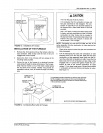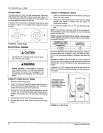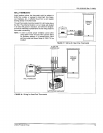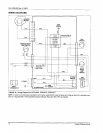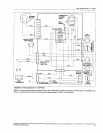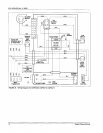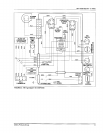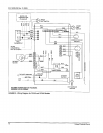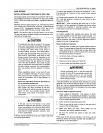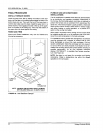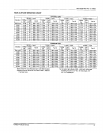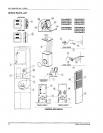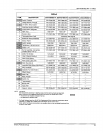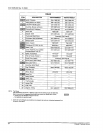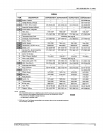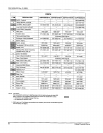
GAS PIPING
INSTALLATION AND CHECKING OF GAS LINE
Gas Supply piping must be sized in accordance with the rec-
ommendations contained in National Fuel Gas Code (ANSI-
Z223.1, NFPA-54) unless local codes or regulations state oth-
erwise.
Matedals used and pipe sizing for U.S. manufactured homes
must comply with requirements contained in Manufactured
Homes Al19.1, Recreational Vehicles Al19.2 and H.U.D.
Title 24, Section 3280.705 and any local or state codes.
NOTE: The gas line inlet on the gas valve is 1/2-14 N.ET
The gas line may be installed through the furnace floor or fur-
nace side to the gas valve.
F& CAUTION
To install gas line and to connect it to the gas
valve, care must be taken to hold gas valve firmly
to prevent misalignment of the bumer orifice, or
to damage gas valve which could result in
improper heating, explosion, fire or asphyxiation.
DO NOT USE EXCESSIVE PIPE SEALANT ON
PIPE JOINTS. Pipe sealant, metal chips or other
foreign material that could be deposited in the
inlet of the gas valve, when gas pipe is installed
or carried through the gas piping into the gas
valve inlet after installation, may cause the gas
valve to malfunction and could result in possible
improper heating, explosion, fire or asphyxiation.
Also, pipe sealant must be resistant to Propane
gas.
Where regulations require, a main shut-off valve
shaft be installed externally of furnace casing.
After piping has been installed, turn gas on and
check aft connections with a leak detector or
soap solution.
Never use open flame to test for gas leaks as
fire or explosion could occur.
Do not test the fuel system at more than 14" HZC.
after furnace has been connected to fuel line.
Such testing could void the warranty. Any test run
above 14" WC. may damage furnace control
valve which could cause an explosion, fire or
asphyxiation.
I CAUTION!
If the gas input to the furnace is too great
because of excessive gas pressure, wrong size
orifice, high altitude, etc., the burnerflame will be
sooty and may produce carbon monoxide, which
could result in unsafe operation, explosion, and/
or fire or asphyxiation.
A dirt leg may be required by some local cedes to trap mois-
ture and contaminations.
035-16328-002 Rev. C (0902)
For natural gas operation, the furnace isdesigned for 7" W.C.
inlet gas pressure. Pressure to main burner is then reduced
to 3 1/2" W.C.
For Propane gas operation, the furnace is designed for 11"
W.C. inlet gas pressure. Pressure to main burner is then
reduced to 10" W.C.
IMPORTANT - When converting gas valve from or to Pro-
pane gas, it will be necessary to change main burner orifice
to prevent an underfired or overfired condition. See label
inside lower furnace door for complete instructions.
Pilot Adjustment
On models equipped with standing pilot ignition, the pilot
should be adjusted so that the flame is approximately 1" in
height (500 BTU / hr.). This will allow proper burner ignition
without excessive fuel usage. The pilot adjustment screw is
located on the top of the gas valve.
Observing Burner Operation
1,
2,
3.
4.
5.
Observe burner to make sure it ignites. Observe color of
flame. On natural gas the flame willburn blue with appre-
ciably yellow tips. On Propane gas a yellow flame may
be expected. If flame is not the proper color call a quali-
fied service technician for service.
Let furnace heat until blower cycles on.
Turn thermostat down.
Observe burner to make sure it shuts off.
Let the furnace cool and blower cycle off.
kWARNING]
Should overheating occur, or the gas supply fail
to shut off, shut off the manual gas valve to the
furnace and allow bomer to run until furnace
cools down and blower shuts off before shutting
off the electdcal supply.
If any abnormalities are observed when checking for correct
operation, such as burner failing to ignite or to turn off, sooty
flame, etc., call your nearest authorized service technician as
shown in the Service Center List included in the home owner
envelope with the furnace.
If Furnace Fails to Operate Properly
1.
2.
3.
4.
5.
Check setting of thermostat - and position of HEAT/
COOL switch if air conditioning is installed. If a set-back
type thermostat is employed be sure that the thermostat
is inthe correct operating mode.
Check to see that electrical power is ON.
Check to see that the knob or switch on the gas control
valve is in the full ON position.
Make sure filters are clean, return gdfies are not
obstructed, and supplyregisters are open.
Be sure that furnace flue piping is open and unob-
structed.
If the cause for the failure to operate is not obvious, do not
attempt to service the furnace yourself. Call a qualified ser-
vice agency or your gas supplier.
Unitary Products Group 19



